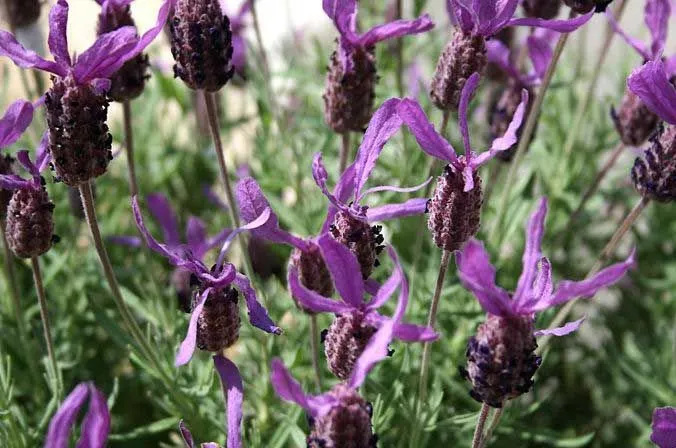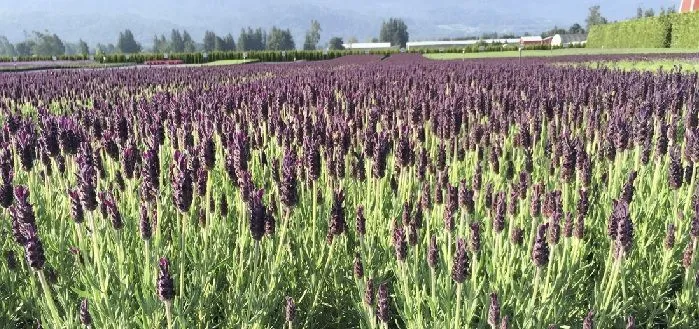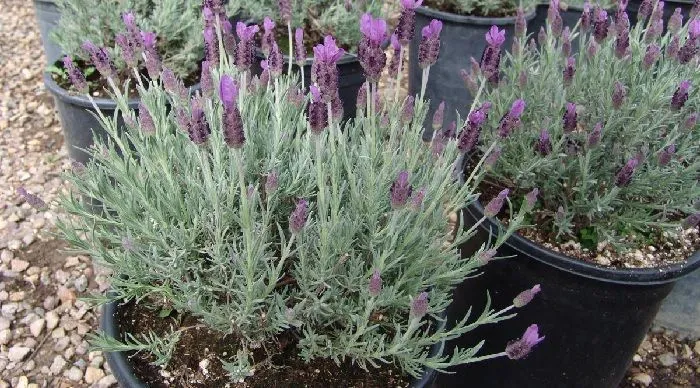It is known as Lavandula stoechas but it is well known as Topped Lavender. If we move through villages or rural and traditional areas it may be better to name it as French Lavender (a very particular name).
Nothing to say about this medical plant except for all the properties it has, if we know how to use it. A plant that we can find in the field and that we can ignore if we do not know it. However, it will not go unnoticed once you know it.
Table of Contents
A brief description of the Topped Lavender or French Lavender
It must also be said that if we search for Topped Lavender online we can find many species, since as often happens, common names bring confusion. Depending on what you are looking for you can find as Topped Lavender the following plants:
- Curly al hoceima or borriquero thyme (Lavandula dentata)
- Alhucemilla or Cantueso (Multifida lavender)
- Our Topped Lavender, also known as French Lavender (Lavandula stoechas)
All these plants have in common their belonging to the genus Lavandula of which, the best known is the lavender that we all know (and of which we can find many accepted taxa).
As for the description of this plant, we can classify it as a larger herb or a small shrub, as it can reach a meter in height and is very branched (like thyme).
It is common to find it growing feral in the Mediterranean area, especially in the Iberian Peninsula and the Balearic Islands. Above all we find it at sea level, in coastal areas or up to 1,000 meters of altitude. Typical of sandy or non-calcareous soils.
The Topped Lavender blooms in spring, about the month of March, although it continues to produce flowers in the following months, before the arrival of summer. They are born in bouquets from the armpit of the leaves, and have a colorful purple ornamentally very aesthetic.
What we are looking for from this plant, either to extract its medicinal or aromatic potential, are the flowers, so the harvesting season will coincide with the flowering season.

Subspecies found in the Mediterranean
Within the species Lavandula stoechas, we can also find subspecies, where among the best known are:
- Lavandula stoechas subsp. pedunculata
- Lavandula stoechas L. subsp. stoechas
- Lavandula stoechas L. subsp. stoechas f. leucantha
- Lavandula stoechas L. subsp. stoechas f. rosea Maire.
- Lavandula stoechas subsp. luisieri (Rozeira) Rozeira
- Lavandula stoechas subsp. sampaioana Rozeira
Of all of them, Lavandula stoechas subsp. pedunculata is the more adapted to cold environments, so it is interesting to select this subtype if we move away to areas where the cold is more intense.
It can be found growing spontaneously in areas of Castilla y León (Spain), growing under soils with a large amount of silicon.
This subtype also blooms in spring and its morphology and appearance does not differ much from the main species, Lavandula stoechas.
Cultivation and care of the Topped Lavender
Lavandula stoechas it can be planted both in the garden and in a pot. Its flowering is extraordinary and will give a leap of quality to our habitat. Its flowering is in spring and can be planted together with other plants that share a flowering period or to give as a pot.
Its cultivation is really simple if we meet a series of conditions. We tell you about it below
The lavender it is a rustic plant, adapted to especially difficult conditions. It has a great resistance to drought and can inhabit any type of soil in the Mediterranean environment.
Weather conditions
Lavandula stoechas is an aclim planttied to the Mediterranean climate. Hot summers and cold winters, with long dry seasons. It can be planted in full sun, being able to see it spontaneously in coastal environments, mountains (below 1000 m of altitude) and covering large areas of scrub.
It usually resists soft and medium frosts, where the temperature does not fall below -4 ºC and does not last for a long time. In flowering, which occurs between spring and summer, temperatures should be above 5-10 ºC.
Soil characteristics
The Topped Lavender is an all-rounder as far as soil adaptation is concerned. It can inhabit the typical soils with alkaline pH of the Mediterranean slope, as it is also seen growing in clay, stony or sandy soils.
If we can choose for your potted crop, the mixture in equal parts between substrate enriched with organic matter and sand will be ideal for the development of your crop.
Irrigation and fertilizer
The Topped Lavender adapts perfectly to soils without humidity and scarce rainfall, being able to inhabit hostile environments for many other plants and where it spends more than 20 or 30 days without having water.
However, its cultivation in the garden or pots should be much more careful, guaranteeing at least 2 weekly waterings in spring and summer (especially with high temperatures) and at least 1 per week in winter, if it has not rained that week.
Especially in the winter months, the amount should be small, enough to maintain a moderately moist substrate. With 300-500 ml per pot of 30 cm will be enough for each watering.

Medicinal applications of Topped Lavender
We always like to find the origin of the medicinal properties of all the plants that we are mentioning. This arises from the compounds that, naturally, have such medicinal plants. In this case, the French Lavender stands out for its content in:
- Cineol
- Borneol
- Terpineol
- D-camphor
- Fenchona
- Linalol
- D-fenchone
Camphor already sounds like some other plant with this compound and, as you know, we use it regularly at home to protect the cabinets from insects. In turn, fenchone is closely related, because it has a very similar chemical structure and a similar smell.
This element can also be found in fennel and, interestingly, in absinthe.
The Terpineol it gives it the characteristic smell of lilacs, so it is a widely used ingredient for the manufacture of different cosmetics and aromatic extracts.
Preferably the medicinal and therapeutic applications of the Topped Lavender are focused on external applications.
Internally, through infusions, is not used very often because high concentrations can be toxic.
However, under medical control or respecting the doses used, you can offer us alternatives to medicines and other supplements.
Infusion of 30 grams of dried Topped Lavender flowers over 1 liter of water
Once left to temper and filter the solids and leftovers, we can drink it by infusion, either alone or mixed with other medicinal plants (such as chamomile), honey or lemon, better digestion of heavy meals or burning sensation.
Before using the Topped Lavender for internal administration, consult a doctor. Not recommended for pregnant women and children under 6 years old
Its intake reduces inflammation of the bronchi and acts as an antipyretic (against fever).
Cooking the flowers: in 1 liter of water are put 30 grams of the floral part of this plant, and cooked. It is allowed to cool and the solid remains of the broth are strained. It can be mixed with honey, sugar or saccharin to improve its taste.
Floral preparation: the flowers are crushed until the essence is achieved, and mixed with half a liter of water. It is applied with gauze or cotton on wounds, burns or sores.
Syrup: the water mixed with the flowers is distilled and strained, to prepare a syrup. It is usually mixed with other medicinal plants to achieve a greater effect.
Topped Lavender essential oil
in some apothecaries and special stores we can find Topped Lavender oil extract. However, if we have availability of plants we can also manufacture them ourselves.s.
Some of the properties attributed to this type of oil:
Healing effect
It acts as a healer for already closed wounds, improving the circulation of the area and reducing inflammation.
Relaxing power
Topped Lavender oil is also used to massage irritated muscles and skin with eczema. Its high odorous power also acts on the nervous system, facilitating relaxation or deeper sleep.
Firming
Applied in massage, it has a firming effect on the skin, making it smoother, younger and hydrated.
Antibacterial action
Some of its essential oils, such as Linalol and Cineol they have a high antibacterial and antimicrobial power. That is why, as we have commented, it can be applied on healed wounds, reducing the proliferation of this type of organisms that complicate the healing of wounds.

Oil preparation mode
To prepare oil from lavandula stoechas we will need to collect fresh leaves, in spring or summer.
We will have to let them dry in the sun so that they lose part of the water and increase the potential of their plant extracts. However, “sun drying” should not be taken at face value. They must be in a cool and dry environment, with light but without direct sun, because it will dry them very quickly.
You can look for virgin olive oil or almond oil. Most experts in treatments recommend almond oil, as it improves its properties with this plant and stimulates its aroma.
Crush the leaves of Topped Lavender menor in a bowl, but without crushing them. What we seek is to release the oil and activate it, but without completely destroying the flowers.
The recipe includes using 3 parts of oil and 1 of flowers of lavandula stoechas. To do this, we will heat the oil over low heat (olive or almond) and then add the flowers. Let heat for at least 1 hour, over minimum heat.
For preserve Topped Lavender oil, the ideal is to close it to avoid the entry of air and keep it in a dark, cool and dry environment, such as inside a closet or pantry.
Aromatic applications of Topped Lavender
As a species of gender Lavandula, it is to be expected all the aromatic properties that we are accustomed to all these species.
There is nothing more intoxicating than a garden where we have some kind of lavender and blows a warm air that displaces through the atmosphere all the aromatic compounds that these crops produce naturally.
With the lavender the same thing happens and, in fact, it is a plant that is used more as an aromatic than as a medicinal plant. The main phytochemical compounds are terpineol (lilac smell) and fenchone and D-fenchone, with the characteristic camphor smell).
In specialized stores we can find different flavoring extracts that use this plant.
Today, there are other plants that also have the same (or almost) compounds of those that are part of the French Lavender and still have more medicinal properties (by having more compounds or in different quantities).
This has caused the Topped Lavender to be displaced by other plants.
The Topped Lavender liqueur
The medicinal plant Topped Lavender is so well known that even in some areas of Spain a characteristic liqueur with a sweet taste is prepared. This Topped Lavender liqueur is known in the province of Alicante, specifically in the town of Monóvar.
It is prepared with the selection of the flower and petiole of the plant through distillation along with alcohol. About 100 grams of sugar is added for each liter of liquor and finally an alcohol of between 25 and 35% is obtained.
The process of elaboration of the Topped Lavender liqueur has with it an aging in wooden barrels of at least 2 months
The most famous liquor is known as Topped Lavender oro, where the flowers with ecological certificate of Sierra de Mariola (natural park included in the interior of the provinces of Alicante) are selected.
In this case, the alcohol content is slightly lower, at 23%, where it matures in copper stills and posterIormente the aging occurs in oak barrels.
Obtaining Topped Lavender honey
As you already know, different types of honey can be obtained depending on the origin of the flowers. Therefore, the final product changes a lot according to the origin, obtaining more acidic, bitter or sweet nuances.
In the case of the Topped Lavender honey, presents a pleasant light amber color, with many floral nuances and a slightly acidic final flavor, fruit of the phytocompounds of the Topped Lavender.
light amber color, which has soft floral aromas and some acidic note and comes from the Topped Lavender flower (Lavandula stoechas).
To ensure the highest quality of Topped Lavender honey, it is requested to have a minimum pollen content of Lavandula stoechas of 12%.
